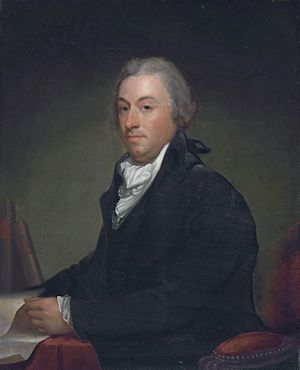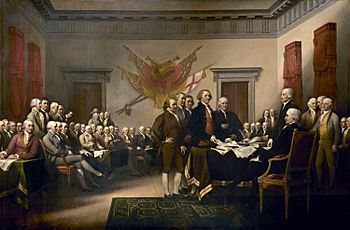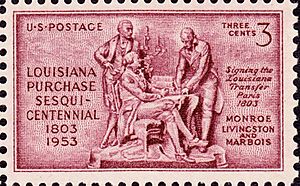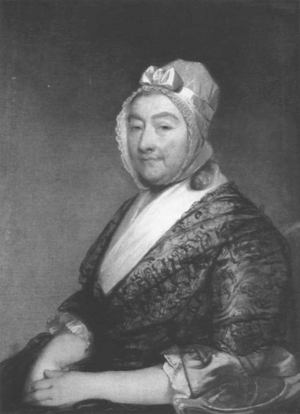Robert R. Livingston (chancellor) facts for kids
Quick facts for kids
Robert Livingston
|
|
|---|---|
 |
|
| 7th United States Minister to France | |
| In office December 6, 1801 – November 18, 1804 |
|
| President | Thomas Jefferson |
| Preceded by | Charles Cotesworth Pinckney |
| Succeeded by | John Armstrong |
| 1st United States Secretary of Foreign Affairs | |
| In office October 20, 1781 – June 4, 1783 |
|
| Appointed by | Congress of the Confederation |
| Preceded by | Position established |
| Succeeded by | John Jay |
| 1st Chancellor of New York | |
| In office July 30, 1777 – June 30, 1801 |
|
| Governor | George Clinton John Jay |
| Preceded by | Position established |
| Succeeded by | John Lansing |
| Personal details | |
| Born | November 27, 1746 New York City, New York, British America |
| Died | February 26, 1813 (aged 66) Clermont, New York, U.S. |
| Political party | Democratic-Republican |
| Spouse |
Mary Stevens
(m. 1770) |
| Children | 2 |
| Relatives | Robert Livingston (father) Edward Livingston (brother) Robert Livingston (grandfather) |
| Education | Columbia University (BA) |
Robert R. Livingston (born November 27, 1746 – died February 26, 1813) was an important American leader. He was a lawyer, a politician, and a diplomat from New York. He is known as one of the Founding Fathers of the United States.
People often called him "The Chancellor" because he held a very high legal job in New York for 25 years. He was part of the Committee of Five that helped write the Declaration of Independence. Other members included Thomas Jefferson, Benjamin Franklin, John Adams, and Roger Sherman. In 1789, Livingston gave the oath of office to George Washington when Washington became the first President.
Contents
Early Life and Education
Robert Livingston was the oldest son of Judge Robert Livingston and Margaret Beekman Livingston. His family was very wealthy and lived in the Hudson River valley in New York. His younger brother, Edward Livingston, also became a U.S. Minister to France later on. Many of his family members were important figures in New York.
Livingston studied at King's College and finished in June 1765. He became a lawyer in 1770. King's College later changed its name to Columbia College of Columbia University after the American Revolution.
Important Roles and Career
Recorder of New York City
In October 1773, Livingston was chosen to be the Recorder of New York City. This was a legal position. However, he supported the American colonists who wanted to be free from British rule. Because of this, he was replaced just a few months later.
First Chancellor of New York
On July 30, 1777, Livingston became the first Chancellor of New York. This was the highest judge in the state at that time. While holding this job, he also served as the first United States Secretary of Foreign Affairs from 1781 to 1783. This was under the first government of the United States, the Articles of Confederation.
Livingston had the honor of giving the presidential oath of office to George Washington. This happened at Washington's first inauguration on April 30, 1789. The ceremony took place at Federal Hall in New York City, which was the nation's capital back then.
In 1789, Livingston joined the Jeffersonian Republicans, who later became known as the Democratic-Republicans. He did not agree with the Jay Treaty or other plans of the Federalist party. He even ran for Governor of New York in 1798 but did not win.
Livingston served as Chancellor for almost 24 years. He left office on June 30, 1801. Even after he left, people continued to call him "Chancellor Livingston" out of respect.
Helping Write the Declaration of Independence


On June 11, 1776, Livingston was chosen for a special group called the Committee of Five. This committee's job was to write the Declaration of Independence. After they decided on the main ideas, Thomas Jefferson wrote the first draft. The committee then reviewed it and made many changes. They showed the updated draft to Congress on June 28, 1776.
Livingston was called back to New York before he could sign the final Declaration. However, his cousin, Philip Livingston, signed the document in his place. Another cousin, William Livingston, later signed the United States Constitution.
U.S. Minister to France
When Thomas Jefferson became President in 1801, he chose Livingston to be the U.S. Minister to France. From 1801 to 1804, Livingston played a key role in negotiating the Louisiana Purchase. This was a huge deal where the United States bought a large area of land from France in 1803. After the agreement was signed, Livingston famously said:
We have lived long but this is the noblest work of our whole lives ... The United States take rank this day among the first powers of the world.
While in France, Livingston met Robert Fulton. Together, they worked on developing the first successful steamboat, called the North River Steamboat. The steamboat's home port was at Livingston's family estate, Clermont Manor. On its first trip, the steamboat left New York City with Livingston on board. It traveled up the Hudson River to Albany in less than 60 hours. Before this, the same journey took almost a week by sailboat. In 1811, Fulton and Livingston also became members of the Erie Canal Commission.
Later Life and Legacy
Livingston was a Freemason. In 1784, he became the first Grand Master of the Grand Lodge of New York. He held this title until 1801. The library of the Grand Lodge in Manhattan is named after him. The Bible he used to give the oath to President Washington is still used today for important ceremonies.
Robert Livingston died on February 26, 1813. He was buried in the family vault at St. Paul's Church in Tivoli, New York.
Personal Life
On September 9, 1770, Robert Livingston married Mary Stevens (1751–1814). Her father was Continental Congressman John Stevens. After they married, Livingston built a home called Belvedere. However, it was burned down by the British Army in 1777. In 1794, he built a new home called New Clermont, which was later named Arryl House. This name was a phonetic spelling of his initials, "RRL." This house was known for being very comfortable and had a library with four thousand books.
Robert and Mary had two daughters:
- Elizabeth Stevens Livingston (1780–1829), who married Lt. Governor Edward Philip Livingston.
- Margaret Maria Livingston (1783–1818), who married Robert L. Livingston.
Honors
- Livingston County, Kentucky, and Livingston County, New York, are named after him.
- A statue of Livingston by Erastus Dow Palmer is in the National Statuary Hall collection at the U.S. Capitol building. Each state can choose two people to be honored there.
- Livingston is also shown on the Jefferson Memorial pediment sculpture. This sculpture honors the Committee of Five who helped draft the Declaration of Independence.
- The Robert Livingston high-rise building at 85 Livingston St. in Brooklyn, NY, is named for him.
Images for kids
-
The Jefferson Memorial's pediment and its sculpture of the Committee of Five
See also
 In Spanish: Robert R. Livingston para niños
In Spanish: Robert R. Livingston para niños





